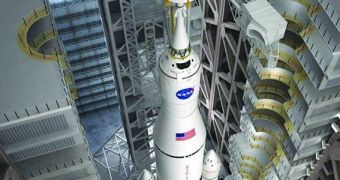During a recent hearing held by the House Science Committee, space tourism pioneer Dennis Tito defended his claim that humans could carry out a flyby of Mars as soon as 2021. Under the current space policy guidelines at NASA, a manned exploration of the Red Planet is scheduled for the 2030s.
Tito first proposed the 2021 time frame for a flyby (not a landing) in early 2013, via a group called Inspiration Mars, which he leads. However, he did mention that the only way for this to happen was for the National Aeronautics and Space Administration (NASA) to get behind the project right now.
On Wednesday, February 26, Tito appeared in front of the HSC to support a version of his proposal, adapted to include the Space Launch System (SLS) delivery system and the Orion Multi-Purpose Crew Vehicle (MPCV) NASA is currently developing.
The two are scheduled to fly together in space for the first time in late 2017/early 2018. With a larger new upper stage rocket engine and an improved, smaller crew habitation module, a flyby mission to Mars becomes possible 3 to 4 years later, the space tourism pioneer told attendants.
NASA has to invest in both the new rocket engine and the habitation module, Tito argued. If the mission is to have any chance of launching in 2021, then work needs to begin right away, since every year lost sets this goal farther back. At this point, the space agency has no such plan on the table.
“I believe that 2021 is possible if the focus is placed on getting that mission on our books. It would take a commitment to develop the full upper stage in the timeframe that we’re talking about. We would [also] need a small [habitation module], perhaps using an existing structure,” added Doug Cooke.
The expert is a former associate administrator of the Exploration Systems Mission Directorate at NASA Headquarters in Washington DC and currently works as a private consultant. He argues that Tito's proposal has a lot of merit and needs to be acted upon as soon as possible.
The director of the Space Policy Institute at the George Washington University, Scott Pace, agrees that the SLS/Orion combo is a “good fit” for Inspiration Mars' proposal. Pace was also a top NASA official during the Bush Administration, when the agency was working on the now-canceled Project Constellation.
The HSC, however, was not as thrilled about the idea, voicing some legitimate concerns about safety, Space News reports.
“Given that 2021 is currently the estimated date for the very first crewed mission of Orion, not just its first deep space mission […] I doubt that a flyby of Mars will ultimately be considered to be an appropriate first shakedown of a new crewed spacecraft, given the risk involved,” said the ranking Democrat on the Committee, Rep. Eddie Bernice Johnson of Texas.

 14 DAY TRIAL //
14 DAY TRIAL //